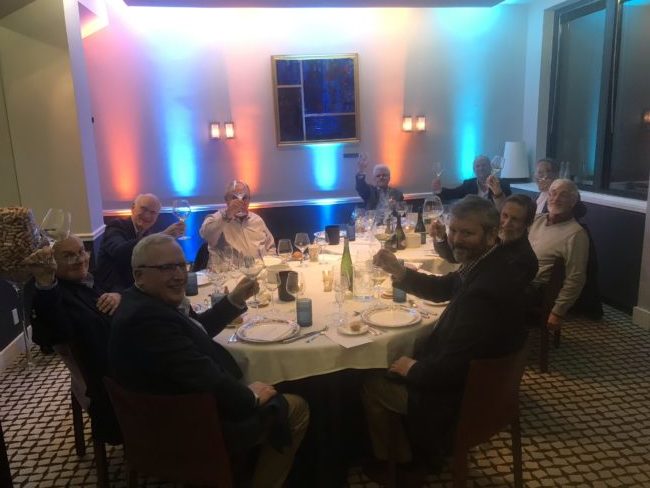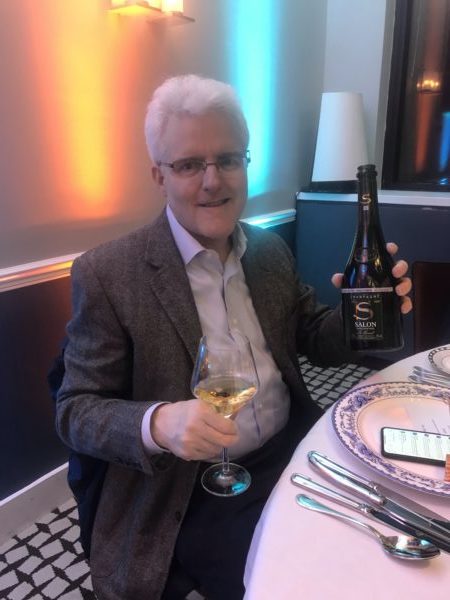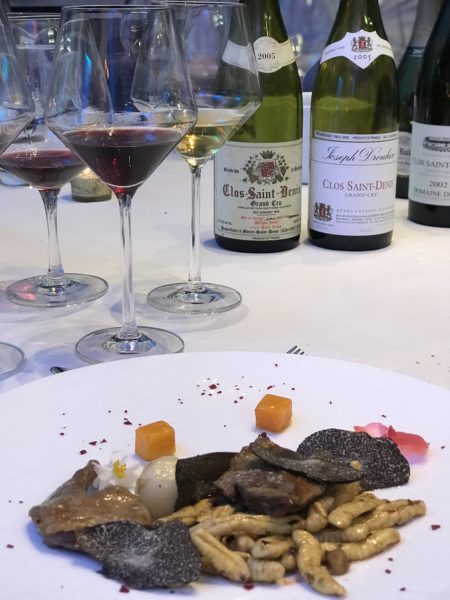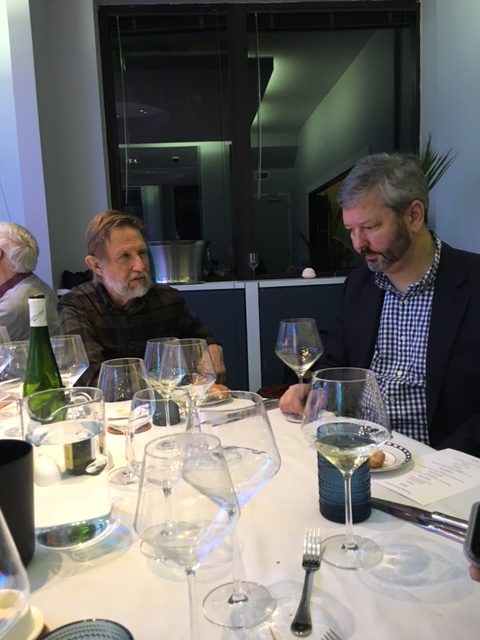Holiday friendship and wine

From grand cru Burgundy, to top Bordeaux and exquisite Champagne, I may have had enough wine for 2020 😉
By Panos Kakaviatos for wine-chronicles.com
13 January 2020
Once a year, old friends gather for a final holidays feast with excellent wines, and this year’s gathering was no exception.
Ken Brown coordinated this year’s dinner at the French Embassy restaurant Petit Bouchon with David Zimmerman, Howard Cooper, Karl Kellar, Kenneth Barr, Scot Hasselman, Randy McFarlane, Christopher Bublitz, Paul Marquardt, Charles Stewart and me.
In the absence of master chef Mark Courseille, his team pulled off a fine series of dishes to go with the many fine wines – nearly 30! – that we enjoyed starting at around 6 pm and ending some five hours later. As per usual, wines in bold I liked in particular. If red and bold, even more. When underlined, too, a kind of wine nirvana.

Happy crew indeed 😊
Part One
We were off to a rock em, sock em start with a foursome of excellent to superb Champagnes. Could it get any better?

The 2007 Dom Ruinart Blanc de Blancs, which I tried last month and liked so much to do a video came across nicely coiled in as a young vintage Champagne would, but full bodied, too, displaying fine ripe pear finesse echoed in the finesse of the bubbles. The finish was marked by lime and wet stone, leaving me with the overall impression of a most smooth and elegant white Burgundy with les bulles. For lovers of tertiary notes in the Champagne, stash this away for a few more years and it will gain in complexity. 94/100

David with the wine of the night. At least one of the top three wines of the night: Salon 1996
Then came the exceptional 2002 Dom Ruinart Rosé Champagne. I saw several of us reach for the bottle a second (or third) time, and the wine was gone fairly quickly. With reason. At once beautifully crisp and full-bodied, “like a super elegant rosé”, Ken Brown commented. The wine blends 80% Grand Cru Chardonnay, 72% from the Côte des Blancs (Avize, Cramant, Le Mesnil-sur-Oger) and 28% from the Montagne de Reims (Puisieulx, Sillery) and 20% Pinot Noir made into red wine, from the Silvery and Verzenay crus. It did 100% malolactic fermentation and has a dosage of 5.5 g/l. Superb balance that demands gastronomic foods. Easily a wine for grilled salmon, roast chicken, even veal. 98/100

Ken Brown with the superb Dom Ruinart Rosé 2002
The third bubbly was the 1993 Taittinger Comtes de Champagne. Notes of hazelnut and toffee. Salted almond. This is pretty taut and lovely for its age. Indeed, the color is excellent, too. An overall impression of being svelte. Paul who brought it said that they had “a good run” in early 1990s, even if the 1993 vintage is not recognized as being that great. Indeed, both Decanter and wine critic John Gilman loved this in rather recent tastings. Rated 97 points by Decanter in a 2017 tasting, the panel noted that 1993 may be an average vintage overall for the region, but this 1993 proved a “real beauty, equal to the 1995 but in a different style.” Gilman gave it 94 out of 100, when he tasted it in 2016. He described the wine as having been “fully mature for many years now, but continues to be fresh and lively on the palate, with its internal structure sound and seamless.” 95/100

And then came one of the wines of the night and for me the wine of the night. Thank you David for bring the now rather legendary 1996 Salon Blanc de Blancs Le Mesnil*. So laser like, with focus but still tasting like a baby! At the same time a pleasing creaminess, like a super high end, home made French butter, finishing with zest and lift, candied red apple freshness. The finish lasted for something like a minute. As we sipped through it (it was gone also rather quickly), the finesse and depth became more evident with just a tiny suggestion of hazelnut to show its age, but really just a smidgeon. “Such precision and laser focus, but bursting with flavor,” remarked Chris. Indeed. 100/100.
Food pairing?
The chestnut soup, see below, proved delectable velouté of chestnut that went best with the Comtes de Champagne, given its evolved aspects, while layers of fresh salmon in “Salmon Napoléon” proved a fine match for the Dom Ruinart Rosé. The parmesan cookie with beet had enough flavor to just match the Salon and the Dom Ruinart Blanc de Blancs. Overall, good pairings, but all of the “Champers” easily would grace a main dish.

Part Two
Flight One: Alsace
1997 Riesling Clos Sainte Hune – Alas not every wine met expectations, and this was the first of several. From the get go, the aromatics were unclean. It had telltale petrol notes and suggestions of white stone fruit, but there was something unsavory about it. Karl wondered if the bottle was corked, but it had another as yet undetermined issue. The palate lacked expected vigor and, as Paul noted, it got worse in glass. Problematic bottle.

The bottle neck broke off as Paul tried to uncork it. Great wine!
Alsace Riesling was saved by the 2001 Riesling Trimbach Cuvée Frederic 375th Anniversary Edition – This wine pleased us as youthful and light gold in aspect, with a smooth and full-bodied palate, displaying wet stone, grapefruit and orange rind. The 5+ grams of residual sugar seamlessly integrated, yielding pristine balance overall and a lingering bright finish. At nearly 20 years old, this wine is on a fine plateau. 95/100

Flight Two: Burgundy
Now with this flight, Howard posed the question if the wines could get any better. It may very well have been the flight of the night. Three superb wines, all white Burgundies.

Like Randy, happy campers with Chassagne Montrachet
Call me crazy but I rate the 2014 Ramonet Chassagne Montrachet Premier Cru Morgeot* almost as highly as the next wine, a grand cru. This has iodine freshness, such vivid oyster shell. The palate is pure sex in glass. OK that is such a cliché, but it is that good. Good sex, of course. This has ripe pear precision with acacia and let’s talk about length! Very long. At 13.5% alcohol the wine is balanced and fresh. I still had some Salon 1996, and went back to it to realize the greatness of this Champagne, coming across as a grand cru white Burgundy, by the way. Anyway just because I loved this premier cru, I gave it a close to perfect 98/100. The buttery smooth texture of the Ramonet exudes both nuance and elegance as well. And for the price, a (relative) steal.

2014 Bouchard Père & Fils Montrachet* – This earns a “bare” 99 point score, and is a different style. You immediately notice the impressive density and power that the Ramonet cannot match. But also, initially at least, less elegance than the preceding wine. The Montrachet seems just a tad too young, as initially the oak derived notes are more noticeable than the fruit, yielding more vanilla and nutmeg over white stone fruit and citrus. Of course there is more weight, and the wine begs grilled lobster with … lots of butter (and lemon). Also clocking in at 13.5% alcohol but the dry extract is impressive. Time in glass reveals its many assets including amazing depth, with a never-ending finish. Bravo Randy for bringing this baby, which should get better with a bit more time in bottle. 99/100

The above two wines were enough of a razzle dazzle that 1988 Bonneau du Martray Corton Charlemagne, also superb, came as if an afterthought. But what an afterthought it was! The initial aromatic impression was lime lemon citrus beckoning sipping. Over 30 years old and still so fresh with no evidence of premature oxidation. You may notice similar recent positive impressions from other tasters on Cellar Tracker. With time in glass, the notes of citrus (more ripe grapefruit on the palate) pair with notions of nougat and a custard pie like sumptuousness to the rather full bodied palate that also exudes much elegance. Anyway, a great wine, and the flight of the night. 97/100

Food pairing?
In the end, we did not have lobster but something close: crawfish on a bed of sea trout mousse with trout caviar in a … lobster sauce. A fine pairing because it was at once delicate and flavorful, and enough to match the wines, but not overshadow them. Indeed, if anything, the Montrachet overpowered the food here. So in a sense, the best food wine pairing was the first wine, as the Bonneau du Martray would have been better with some morel mushrooms or even truffle in a white cream sauce and fish, for example.

Howard making a point with David and me in the background (photo by Randy)
Part Three
Two flights of red Burgundy: one very strong, the other OK
Flight One
2005 Philippe Jouan Clos Saint-Denis – Slight cinnamon nose. Clafoutis cherry. Some dark chocolate. Smooth and refined. Still a bit closed on the palate. Indeed the palate is a tad steely. “If I want to drink one of these 2005s today, I would drink the Drouhin”, which came next, remarked Ken Brown. “If in 10 years, the Jouan”. Indeed, the wine has much depth and length but not “firing on all cylinders” at this stage. Great to make an assessment however in year 15. It was getting better and better in glass. 94/100

Excellent pairing with a … pair of Clos-Saint-Denis
2005 Joseph Drouhin Clos Saint Denis – Warmer cherry, riper aspect – on the nose! Red licorice. The palate is rich, without being “dense” like, say, the Montrachet Blanc 2014. Easier access and it shows, when compared to the preceding wine. Ripe and sumptuous. Some liked it more than others, but as Ken said, it is the wine to drink today. Chris Bublitz just loved this one, and I did too. 95/100
2002 Domaine Dujac Clos St Denis – Noticeably older brick red in aspect than both 2005s. The nose is complex, with an evident mix of red and dark fruits (black cherry, dark plums) and some floral aspects that beckon sipping. The palate is finely balanced, exuding the ripe fruit but also a mineral like earthiness quite fresh in aspect. Indeed, I was getting burgeoning animal with those fresh forest floor after rainfall notes. This turned out to be my second favorite red Burgundy of the evening. Lovely! 96/100

An even better pairing with a pair of … 2002s
2002 Jean-Jacques Confuron Romanée Saint-Vivant – And here my favorite of the evening among the red Burgundies. Although it started off a bit steely at first, time in glass revealed its veritable charm. The aromatics seduce you from the get go, with truffle, notions of Havanna cigar, fresh earthiness, red and black fruit, and more truffle. As said the initial palate seemed a tad steely, but the wine if I recall was popped and poured. You end up with a palate that gets more opulent but always nicely balanced with tension and energy. The red fruit aspect is there as well as darker fruit, a sign of the vintage’s ripeness. Aged in 100% new oak, nicely integrated and absorbed, so you get tannin for the longer haul. Pristine red Burgundy. 97/100
Flight Two
1999 Mugneret-Gibourg Echezeaux – Fine and smooth and with much poise balancing fruit and tertiary aspects, but it did not perform nearly as well as when I last enjoyed it back in 2014. I did not take as careful notes as I would have liked, but was left just a tad underwhelmed as this followed two more interesting wines for my palate. Perhaps I was caught not concentrating as much as I should have been? 93/100
1995 Mugneret-Gibourg Clos Vougeot – This bottle seemed a bit to affected by brett to get too excited about. Was not really enjoying it. Problematic bottle or was there just too much wine to focus?
1983 Pierre Bourée Clos de la Roche – Scot brought this and this 1983 is more than just a decent wine for the vintage. Many preferred the previous wines, but this came across more pure and delicious. A bit edgy, sure, and not matching any of the wines in the previous flight, but for me it had the most character. I am an outlier here most likely… 94/100
Food pairing?
Wow this was perhaps my overall favorite of the dinner, a sumptuous roast squab breast with black truffle and Cavatelli pasta in a wine infused Périgourdine sauce. So delectable and the older profile of the 1983 went nicely down with the dish’s richness, although the most pleasurable pairing proved to be the two 2002s.

Chris opening the Château Palmer 1966 he brought to the dinner
Part Four
Two flights of Bordeaux: One very strong, the other, alas, marred by bad bottles/corks
Flight One
This first flight was my favorite flight of reds. All three wines were great!
1986 Château Lafite Rothschild – Very pencil lead. Rather impenetrable. Very graphite nose. The palate is welcoming. It has richness and ripe cassis aspects. Smooth. A touch austere. Maybe we needed more time with this but it lacked the visceral appeal of the next two wines. Some were oohing and aahing, but give me more of the next two. 95+/100

Superb Bordeaux flight: two “firsts” and a “super second”.
1996 Château Pichon Longueville Comtesse de Lalande – More fruit driven nose here. Graphite too, but not as direct in aspect as the preceding wine. The mid palate has lovely, bright fruit. Always such a nice wine! It is bright and crunchy fruit, and fresh. Here we are in 2020, and this wine is almost 25 years old and tastes fresh. Orange rind. Fresh. For Chris Bublitz, his preference. And mine, too. 97/100
1996 Château Mouton Rothschild – Dark cassis and red and black cherry. The palate shows tobacco and lots of still unresolved tannin; a beautiful wine! Give it more time. It is an amazing wine! The tannic edge and power makes me tip my hat to this wine as the wine of the flight and perhaps red wine of the night. Still not as good or as highly scored as the white Burgundies, but truly up there. It will only get better in 5 years (and even better in 10). Tour de force, as they say. 98/100
Flight Two
Alas, we have tried these vintages before and have had better bottles, but such is the case with older wines. Some bottles/corks have aged better than others. 😉
1966 Château Palmer – We started things off on a strong note. Subtle notes of ripe red fruit. Stewed fruit. Spice. The palate is just a tad too easy… as compared to expectations. That is to say, when I enjoyed this wine a couple of years ago, the cork/bottle/provenance proved better, with more evident structure and depth. Although I have had one or two better versions, this remained a lovely wine, over 50 years old! Thank you Chris! 95/100

1966 Château Haut Brion – Band-Aid. Could not get past the nose. Ugly.
1970 Château Mouton Rothschild – Cabbage. Problematic. But the palate was pretty tasty. Just a bit hard tannin and basically a bit hard. Should be better. Volatile acidity evident.
1970 Château Haut Brion – Brett. On the nose. The palate? Like sucking on a Band-Aid.
For these last three, point proven: after a certain number of years in bottle, you talk no more of great wines, but great bottles (corks, provenance etc).
Food pairing?
Delectable and perfectly cooked lamb loin, accentuated by eggplant caviar, glazed vegetables and mushroom in an orange sauce, as you can see in the featured title image for this post. A dish that paired best with the Pichon Comtesse as its sumptuous generosity matched the meat and eggplant. The Mouton went well with it, too. Also the Palmer was nice, although mushroom and truffle would have better matched the 1966.

Deep in wine tasting thoughts: Karl (left) conferring with Ken. (Photo by Randy)
End Game (Part Five)
A couple of Germans
1976 Zimmerman Bernkastler-Kueser Kardinalsberg Riesling Beerenauslese – By comparison to the 1990 ice wine, tasted next, this was a bit tired and had aromas of a just caught fish. A bit sardine like. The palate is better. Smoother and more fruit driven. But nothing compared to the 1990, next up.

1990 Selbach-Oster Zeltinger Schlossberg Eiswein – Quite a bit of icy focus! There is a sorbet aspect to this wine. Rich and lovely. A meal unto itself. The nose here is a touch cloying. But the palate exudes quite pleasing citrus. 93/100
Four Sauternes/Barsacs
Great to compare a trio of Château Climens Barsac. The 1988 Château Climens stuck out most in my experience. Coming from a half bottle and still such energy and depth, with tobacco and black tea and toffee notes, quite a bit of aromatic complexity, focus and energy. A brilliant vintage for the region. Vivacity and desire to enjoy with food as well as on its own. 96/100. By contrast, coming from a regular bottle, the 1986 Château Climens came across more austere, but exuded subtle intensity. A lovely wine, but I prefer the 1988. 93/100. A more recent vintage, the 2003 Château Climens exuded lovely brightness for the infamously hot vintage. Honey. Mango. Richness and opulence and a Kiwi sweet aspect, ending on a note of fresh cut pineapple. Very nice! 95/100. We also had another 1988, the 1988 Château Guiraud Sauternes, also from a 375 bottle, which came across predictably sweeter by comparison with the Climens, and not as nuanced. Good stuff. 93/100

Not a bad night: 28 wines
Food pairing?
The wines above could have been meals unto themselves but I rather devoured the Praline Jivarra Bar with Sorbet Passion Mango. It was so tasty, rich and fresh, given the sorbet. The best pairing was the Eiswein, as reflecting the cooler aspects of the Sorbet. But I was not really paying close attention on the pairing chemistry by this time…

David and Scot reflecting the mood of the evening.
Most important: a word of thanks to wine buddies that gathered together. Dear friends, all. And the fact that we share this common wine geeky passion made the evening all the more sweet, as a way to finalize the holidays and welcome the year 2020. Here’s to more great wine (and food) adventures to you and yours.
 Wine Chronicles
Wine Chronicles
Share This